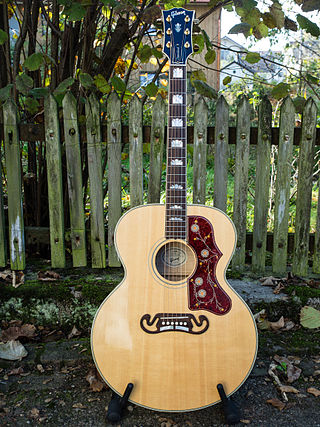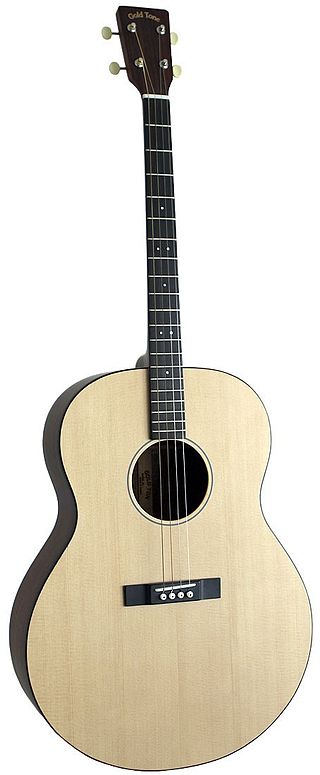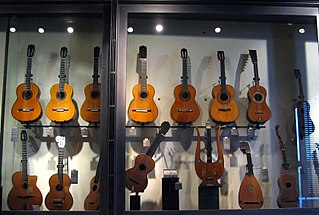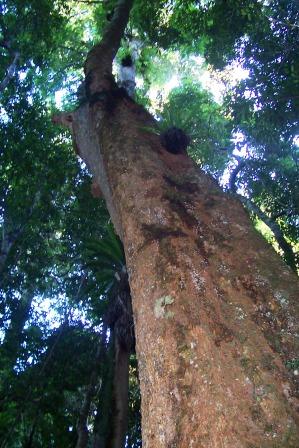
The steel-string acoustic guitar is a modern form of guitar that descends from the gut-strung Romantic guitar, but is strung with steel strings for a brighter, louder sound. Like the modern classical guitar, it is often referred to simply as an acoustic guitar, or sometimes as a folk guitar.

Wood is a structural tissue found in the stems and roots of trees and other woody plants. It is an organic material – a natural composite of cellulose fibers that are strong in tension and embedded in a matrix of lignin that resists compression. Wood is sometimes defined as only the secondary xylem in the stems of trees, or more broadly to include the same type of tissue elsewhere, such as in the roots of trees or shrubs. In a living tree it performs a support function, enabling woody plants to grow large or to stand up by themselves. It also conveys water and nutrients between the leaves, other growing tissues, and the roots. Wood may also refer to other plant materials with comparable properties, and to material engineered from wood, woodchips, or fiber.

Mahogany is a straight-grained, reddish-brown timber of three tropical hardwood species of the genus Swietenia, indigenous to the Americas and part of the pantropical chinaberry family, Meliaceae. Mahogany is used commercially for a wide variety of goods, due to its coloring and durable nature. It is naturally found within the Americas, but has also been imported to plantations across Asia and Oceania. The mahogany trade may have begun as early as the 16th century and flourished in the 17th and 18th centuries. In certain countries, mahogany is considered an invasive species.

Cocobolo is a tropical hardwood of Central American trees belonging to the genus Dalbergia. Only the heartwood of cocobolo is used; it is usually orange or reddish-brown, often with darker irregular traces weaving through the wood. The heartwood changes color after being cut and can be polished to a lustrous, glassy finish; being quite dense, sometimes having a specific gravity of over 1.0, it will sink in water. The sapwood is a creamy yellow, with a sharp boundary between it and the heartwood.

Acacia koa, commonly known as koa, is a species of flowering tree in the family Fabaceae. It is endemic to the Hawaiian Islands, where it is the second most common tree. The highest populations are on Hawaiʻi, Maui and Oʻahu.

Epiphone is an American musical instrument brand that traces its roots to a musical instrument manufacturing business founded in 1873 by Anastasios Stathopoulos in İzmir, Ottoman Empire, and moved to New York City in 1908. After taking over his father's business, Epaminondas Stathopoulos named the company "Epiphone" as a combination of his own nickname "Epi" and the suffix "-phone" in 1928, the same year it began making guitars. From the 1930s through to the early 1950s, Epiphone produced a range of both acoustic and (later) electrified archtop guitars that rivalled those produced by Gibson and were the instruments of choice of many professionals; a smaller range of flat-top guitars were also produced, some designations of which were later continued during the Gibson-owned era for the company.

Aucoumea klaineana is a tree in the family Burseraceae, native to equatorial west Africa in Gabon, the Republic of the Congo, and Río Muni. It is a large hardwood tree growing to 30–40 m tall, rarely larger, with a trunk 1.0–2.5 m diameter above the often large basal buttresses. The tree generally grows in small stands, with the roots of the trees intertwined with neighboring trees. In Gabon, it is the primary timber species.

Bulnesia sarmientoi is a tree that inhabits a part of the Gran Chaco area in South America, around the Argentina-Bolivia-Paraguay border. Its wood is often traded as "Paraguay lignum vitae", since it has properties and uses similar to the "true" lignum vitae trees of genus Guaiacum, which are close relatives. Another trade name is "vera" or "verawood", which may also refer to the even more closely related B. arborea. Another common but rather ambiguous name is palo santo, which it shares with the species Bursera graveolens.

The tenor guitar or four-string guitar is a slightly smaller, four-string relative of the steel-string acoustic guitar or electric guitar. The instrument was initially developed in its acoustic form by Gibson and C.F. Martin so that players of the four-string tenor banjo could double on guitar.

Entandrophragma cylindricum is a tree of the genus Entandrophragma of the family Meliaceae. It is commonly known as sapele or sapelli or sapele mahogany, as well as aboudikro, assi, and muyovu.

Rosewood is any of a number of richly hued hardwoods, often brownish with darker veining, but found in other colours. It is hard, tough, strong, and dense. True rosewoods come from trees of the genus Dalbergia, but other woods are often called rosewood. Rosewood takes a high polish and is used for luxury furniture-making, flooring, musical instruments, and turnery.

The Gibson Hummingbird is an acoustic guitar model/series produced by the Gibson Guitar Corporation.

The following outline is provided as an overview of and topical guide to guitars:

A headstock or peghead is part of a guitar or similar stringed instruments such as a lute, mandolin, banjo, ukulele and others of the lute lineage. The main function of a headstock is to house the tuning pegs or other mechanism that holds the strings at the "head" of the instrument; it corresponds to a pegbox in the violin family. At the "tail" of the instrument the strings are usually held by a tailpiece or bridge. Machine heads on the headstock are commonly used to tune the instrument by adjusting the tension of strings and, consequently, the pitch of sound they produce.

Cedrela odorata, commonly known as Spanish cedar, Cuban cedar, or cedro in Spanish, is a commercially important species of tree in the chinaberry family, Meliaceae native to the Neotropics.
Tonewood refers to specific wood varieties used for woodwind or acoustic stringed instruments. The word implies that certain species exhibit qualities that enhance acoustic properties of the instruments, but other properties of the wood such as esthetics and availability have always been considered in the selection of wood for musical instruments. According to Mottola's Cyclopedic Dictionary of Lutherie Terms, tonewood is:
Wood that is used to make stringed musical instruments. The term is often used to indicate wood species that are suitable for stringed musical instruments and, by exclusion, those that are not. But the list of species generally considered to be tonewoods changes constantly and has changed constantly throughout history.
Guibourtia ehie is an evergreen tree of the genus Guibourtia in the family Fabaceae, also known by the common names amazique, amazoué, hyedua, black hyedua, mozambique, ovangkol and shedua.

Pterocarpus dalbergioides, the Andaman padauk, Andaman redwood or East Indian mahogany, is a species of flowering plant in the family Fabaceae. It is sometimes called "narra", but this is just a generic term used for any of several Pterocarpus species. It is native to the Andaman Islands.

Didymocheton fraserianus, commonly known as rosewood or rose mahogany, is a medium-sized to large tree native to New South Wales and Queensland. It is widely used with the purpose of street design and to provide shade in the eastern suburbs of Sydney. Rosewood ranges from the rainforest around eastern Australia from Bundaberg in Queensland to Wyong in New South Wales. At maturity, it can reach a height of 57 metres (200 ft). It is generally known for its strong scent of rose from its bark.

Eucalyptus acmenoides, commonly known as white mahogany or barayly, is a tree that is endemic to eastern Australia. It is a large tree with grey to reddish brown, stringy bark, lance-shaped leaves, oval to spindle-shaped buds and more or less hemispherical fruits. The two sides of adult leaves are very different shades of green.


















